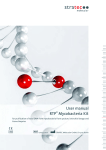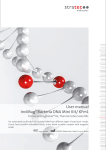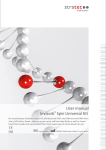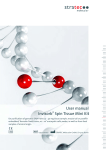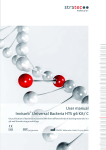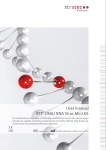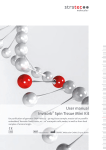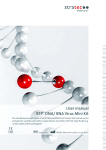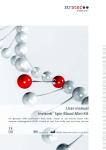Download RTP Bacteria DNA Mini Kit User manual
Transcript
User manual RTP® Bacteria DNA Mini Kit for purification of genomic DNA from bacteria species included in different kinds of starting materials IVD REF 1033200x00 STRATEC Molecular GmbH, D-13125 Berlin Instruction for the RTP® Bacteria DNA Mini Kit The RTP® Bacteria DNA Mini Kit allows rapid and efficient isolation of high quality high chromosomal bacterial DNA from bacterial species, tissue samples, paraffin embedded tissue, urine, paper points, swabs and water using the RTP® technology. The purified DNA can be used for in-vitro diagnostic analysis. The kit is neither validated for the isolation of genomic DNA from cell free body fluids, like cerebrospinal fluid, synovial fluid or for DNA from stool sample, parasites or the purification of total RNA. The application of the kit for isolation and purification of viral DNA has not been evaluated. IVD Compliance with EU Directive 98/79/EC on in vitro medical devices. Not for in-vitro diagnostic use in countries where the EU Directive 98/79/EC on in vitro medical devices is not recognized. ® ® ® ® Trademarks: Invisorb , RTP , InviMag , Eppendorf . Registered marks, trademarks, etc. used in this document, even when not specifically marked as such, are not to be considered unprotected by law. ® The Invisorb technology is covered by patents and patent applications: US 6,110363, US 6,043,354, US 6,037,465, EP 0880535, WO 9728171, WO 9534569, EP 0765335, DE 19506887, DE 10041825.2, WO 0034463. ® ® ® Invisorb , RTP and InviMag are registered trademarks of STRATEC Biomedical AG. The PCR process is covered by US Patents 4,683,195, and 4,683,202 and foreign equivalents owned by Hoffmann-La Roche AG. © 2013 STRATEC Molecular, all rights reserved. 1 ® RTP Bacteria DNA Mini Kit 0513 Contents Kit contents of RTP® Bacteria DNA Mini Kit 3 Symbols 4 Storage 4 Quality control 4 Intended use 5 Product use limitations 5 Safety information 6 Product characteristic of RTP® Bacteria DNA Mini Kit 7 Principle and procedure 8 Important notes 9 Important points before starting a protocol 9 Preparing reagents and buffers 10 Equipment and reagents to be supplied by user 11 ® Scheme of RTP Bacteria DNA Mini Kit 12 Protocols Protocol 1: Isolation of bacterial DNA from swabs 13 9 Protocol 2: Isolation of DNA from bacteria pellets (1 x 10 bacteria cells) 14 Protocol 3: Isolation of bacterial DNA from Listeria ssp. from food samples, 15 Protocol 4: Isolation of DNA from periodonthopathogenic bacteria from 16 paper points Protocol 5: Isolation of bacterial DNA from tissue biopsies 17 Protocol 6: Isolation of bacterial DNA from paraffin embedded tissue sample 18 Protocol 7: Isolation of bacterial DNA from urine sample 19 Protocol 8: Isolation of bacterial DNA from water sample (big volume) 20 Troubleshooting 21 Appendix 22 22 General notes on handling DNA Ordering information 23 2 ® RTP Bacteria DNA Mini Kit 0513 Kit contents of RTP® Bacteria DNA Mini Kit Store all kit components at room temperature (RT) Catalogue No. Extraction Tube L Resuspension Buffer R Binding Buffer B6 Elution Buffer Wash Buffer I 5 DNA-extractions 50 DNA-extractions 250 DNA-extractions 1033200100 1033200200 1033200300 5 50 5 x 50 2 x 2 ml 30 ml 150 ml 3 x 1 ml 9 ml 36 ml (ready to use) (final volume 30 ml) (final volume 120 ml) 2 ml 30 ml 120 ml 15 ml 30 ml 80 ml (ready to use) (final volume 60 ml) (final volume 160 ml) 15 ml 18 ml 60 ml (ready to use) (final volume 60 ml) (final volume 200 ml) RTA Spin Filter Set 5 50 5 x 50 RTA Receiver Tube 5 50 5 x 50 1.5 ml Receiver Tubes 5 50 5 x 50 Manual 1 1 1 Add 21 ml 99.7% Isopropanol to the Binding Buffer B6. Mix by intensive shaking by inverting for 1 min. Shortly before use mix by inverting several times. Add 84 ml 99.7% Isopropanol to the Binding Buffer B6. Mix by intensive shaking by inverting for 1 min. Shortly before use mix by inverting several times. Add 30 ml of 96% - 100 % ethanol to the bottle Wash Buffer I, mix shortly and keep the bottle always firmly closed! Add 80 ml of 96% - 100 % ethanol to the bottle Wash Buffer I, mix shortly and keep the bottle always firmly closed! Add 42 ml of 96% - 100% ethanol to the bottle Wash Buffer II, mix shortly and keep the bottle always firmly closed! Add 140 ml of 96% - 100% ethanol to each bottle Wash Buffer II, mix shortly and keep the bottle always firmly closed! Wash Buffer II Initial steps 3 ® RTP Bacteria DNA Mini Kit 0513 Symbols Lot number Catalogue number Date of manufacture Expiry date Consult operating instructions Temperature limitation Do not reuse Storage The RTP® Bacteria DNA Mini Kit including the Extraction Tubes (incl. Lysis Buffer, Proteinase K, Carrier RNA, Lysozyme and Internal Control DNA) should be stored dry, at room temperature (RT) and is stable for at least 12 months under these conditions. Wash Buffer I and Wash Buffer II charged with ethanol should be appropriately sealed and stored at room temperature. Before every use make sure that all components have room temperature. If there are any precipitates within the provided solutions dissolve these precipitates by carefully warming up to room temperature (up to 30°C). Room temperature (RT) is defined as range from 15 - 30°C. Quality control and product warranty STRATEC Molecular warrants the correct function of the RTP® Bacteria DNA Mini Kit for applications as described in this manual. Purchaser must determine the suitability of the Product for its particular use. Should any Product fail to perform the applications as described in the manual, STRATEC Molecular will check the lot and if STRATEC Molecular investigates a problem in the lot, STRATEC Molecular will replace the Product free of charge. STRATEC Molecular reserves the right to change, alter, or modify any Product to enhance its performance and design at any time. In accordance with STRATEC Molecular’s ISO 9001-2000 and ISO EN 13485 certified Quality Management System the performance of all components of the RTP® Bacteria DNA Mini Kit Kit have been tested separately against predetermined specifications routinely on lot-to-lot to ensure consistent product quality. If you have any questions or problems regarding any aspects of RTP® Bacteria DNA Mini Kit or other STRATEC Molecular products, please do not hesitate to contact us. A copy of STRATEC Molecular’s terms and conditions can be obtained upon request or are presented at the STRATEC Molecular webpage. For technical support or further information please contact: from Germany +49-(0)30-9489-2901/ 2910 from abroad +49-(0)30-9489-2907 or contact your local distributor. 4 ® RTP Bacteria DNA Mini Kit 0513 Intended use The RTP® Bacteria DNA Mini Kit allows rapid and efficient isolation of high quality DNA from bacterial species, food and tissue samples, paraffin embedded tissue, urine, paper points, swabs and water using the RTP® technology. This kit technology yields bacterial DNA from different human samples that is free of proteins, nucleases and other impurities and is ready to use for different downstream applications, such as PCR, quantitative PCR and others. The purified DNA can be used for in-vitro diagnostic analysis only. THE PRODUCT IS INDENTED FOR USE BY PROFESSIONAL USERS ONLY, SUCH AS TECHNICIANS, PHYSICIANS AND BIOLOGISTS TRAINED IN MOLECULAR BIOLOGICAL TECHNIQUES. It is designed to be used with any downstream application employing enzymatic amplification or other enzymatic modifications of DNA followed by signal detection or amplification. Any diagnostic results generated by using the sample preparation procedure in conjunction with any downstream diagnostic assay should be interpreted with regard to other clinical or laboratory findings. To minimize irregularities in diagnostic results, adequate controls for downstream applications should be used. The kit is in compliance with EU Directive 98/79/EC on in vitro medical devices. But it is not for in-vitro diagnostic use in countries where the EU Directive 98/79/EC on in vitro medical devices is not recognized. Product use limitation The kit is neither validated for the isolation of genomic DNA from cell free body fluids, like cerebrospinal fluid, synovial fluid or for DNA from stool sample, parasites or the purification of total RNA. The application of the kit for isolation and purification of viral DNA has not been evaluated. The included chemicals are only useable once. Differing of starting material or flow trace may lead to inoperability; therefore neither a warranty nor guarantee in this case will be given, neither implied nor express. The user is responsible to validate the performance of the STRATEC Molecular Product for any particular use. STRATEC Molecular does not provide for validation of performance characteristics of the Product with respect to specific applications. STRATEC Molecular Products may be used e.g.in clinical diagnostic laboratory systems conditioned upon the complete diagnostic system of the laboratory the laboratory has been validated pursuant to CLIA’ 88 regulations in the U.S. or equivalents in other countries. All Products sold by STRATEC Molecular are subject to extensive quality control procedures (according to ISO 9001-2000 and ISO EN 13485) and are warranted to perform as described herein. Any problems, incidents or defects shall be reported to STRATEC Molecular immediately upon detection thereof. The chemicals and the plastic parts are for laboratory use only; they must be stored in the laboratory and must not be used for purposes other than intended. The Product with its contents is unfit for consumption. 5 ® RTP Bacteria DNA Mini Kit 0513 Safety information When and while working with chemicals, always wear a suitable lab coat, disposable gloves, and protective goggles! Avoid skin contact! Adhere to the legal requirements for working with biological material! For more information, please consult the appropriate material safety data sheets (MSDS). These are available online in convenient and compact PDF format at www.stratec.com for each STRATEC Molecular Product and its components. If buffer bottles are damaged or leaking, WEAR GLOVES, AND PROTECTIVE GOGGLES when discarding the bottles in order to avoid any injuries. STRATEC Molecular has not tested the liquid waste generated by the RTP® Bacteria DNA Mini Kit procedures for residual infectious materials. Contamination of the liquid waste with residual infectious materials is highly unlikely, but cannot be excluded completely. Therefore, liquid waste must be considered infectious and be handled and discarded according to local safety regulations. Below is listed European Community risk and safety phrases for the components of the RTP® Bacteria DNA Mini Kit to which they apply Wash Buffer I Extraction Tube L warning H302-312-332-412 EUH032 P273 H319: H302: H312: H332: H412: EUH032: H314: EUH208: P305+P351+P338: P273: P260: P280: P310: danger H302-314 EUH208 P260-280-305-351-338-310 Causes serious eye irritation. Harmful if swallowed. Harmful in contact with skin. Harmful if inhaled. Harmful to aquatic life with long lasting effects. Contact with acids liberates very toxic gas. Causes severe skin burns and eye damage. Contains Proteinase K. May produce an allergic reaction. IF IN EYES: Rinse cautiously with water for several minutes. Remove contact lenses, if present and easy to do. Continue rinsing. Avoid release to the environment. Do not breathe dust/fume/gas/mist/vapours/spray. Wear protective gloves/protective clothing/eye protection/face protection. Immediately call a POISON CENTER or doctor/physician. Emergency medical information can be obtained 24 hours a day from infotrac: outside of USA: in USA : 1 – 352 – 323 – 3500 1 – 800 – 535 – 5053 6 ® RTP Bacteria DNA Mini Kit 0513 Product characteristic of the RTP® Bacteria DNA Mini Kit Starting material max. 109 bacteria, 1-10 mg tissue, biopsy material, paraffin embedded tissue, swabs 15-50 ml urine, paper points Yield depends on the starting material Time Ratio 25 min (without lysis time) A260 : A 280 1,7 – 2,0 The RTP® Bacteria DNA Mini Kit allows rapid and efficient isolation of high quality genomic DNA from bacteria species (up to 109 bacteria cells) included in different kinds of starting materials (bacteria pellets, paper points). The kit uses the patented RTP® technology, whose special feature is the utilization of an Extraction Tube L containing preformulated solid lysis reagent, lytic enzyme, Proteinase K, carrier nucleic acid and a precisely calibrated amount of an internal DNA Extraction Control. The internal control is a convenient tool for the assessment and monitoring of extraction efficiency and PCR amplification as well, for the quality of the purified nucleic acid , and for the exclusion of false negative results. Using the RTP® Bacteria DNA Mini Kit, all types of samples are transferred into the Extraction Tubes together with a specially designed Resuspension Buffer. The prefilled buffer and enzymes lyse the samples, stabilize nucleic acid and enhance the selective DNA adsorption to the membrane. The membranes are efficiently washed before the nucleic acid is eluted. In addition to the rigorous lysis procedure, simple pretreating steps have been introduced, ideally for purification of genomic DNA, especially from gram positive bacteria of different sources. High extraction efficiency and detection sensitivities will be realized. No phenol chloroform extraction is required. The “hands-on time“ necessary for the whole procedure is reduced to a minimum. All kit components can be stored at room temperature. The procedures require minimal interaction by the user, allowing safe handling of potentially infectious samples. Due to the high purity, the isolated total DNA is ready to use for a broad panel of downstream applications (see below) or can be stored at –80°C for subsequent use. ż ż ż ż PCR* Real-time PCR (quantitative RT-PCR, like TaqMan und LightCycler technology) Mircoarray application RFLP-Analysis To purify high chromosomal bacterial DNA in 96 format STRATEC Molecular offers the Invisorb® Universal Bacterial HTS 96 Kitfor use in a centrifuge and on common laboratory automated workstations. Furthermore STRATEC Molecular offers the InviMag® Bacteria DNA Mini Kit KFmL and KF96 for DNA isolation using magnetic beads. For further information please contact: Tel.: +49 (0) 30 9489 2901, 2910 in Germany and from foreign countries Tel.: +49 (0) 30 9489 2907 or your local distributor. *) The PCR method is covered by U.S. Patents 4,683,195 and 4,683,202 owned by Hoffmann-LaRoche Inc. The purchase of the RTP® Bacteria DNA Mini Kit cannot be construed as an authorization or implicit licence to practice PCR under any patents held by Hoffmann-LaRoche Inc. 7 ® RTP Bacteria DNA Mini Kit 0513 Principle and procedure The RTP® Bacteria DNA Mini Kit procedure comprises following steps: ż ż ż ż lysis at different temperatures binding the nucleic acids in the lysate to the membrane of a RTA Spin Filter washing of the membrane and elimination of contaminants and ethanol elution of nucleic acid This manual contains 8 protocols. Sampling and storage of starting material: Pathogens (Listeria ssp.) in food material: For the detection of bacteria (Listeria) in foods they must be enriched and cultivated following the EU regulations and § 35 of the food law. An aliquot of the culture will only be used and the bacteria will be pelleted after cultivation. Best results are obtained with fresh material or material that has been immediately frozen and stored at –20°C or –80°C. Repeated freezing and thawing of stored samples should be avoided, since this leads to reduced DNA size. Bacterial cultures: Bacterial cultures grow in the presence of a selective agent such as an antibiotic. The yield and quality of DNA may depend on factors such host strain, inoculation, antibiotic, and type of culture medium. The bacteria will be pelleted after cultivation. Best results are obtained with fresh material or material that has been immediately frozen and stored at –20°C or –80°C. Repeated freezing and thawing of stored samples should be avoided, since this leads to reduced DNA size. Paper Points: These can be stored at room temperature up to 6 hours. For long term storage, we recommend dry storage at 2-8°C. Biopsy material / tissue / paraffin embedded tissue: Best results are obtained with fresh material or material that has been immediately frozen and stored at –20°C or –80°C. Repeated freezing and thawing of stored samples should be avoided, since this leads to reduced DNA size. Use of poor quality starting material influences yield of purified DNA. The thawing process could proceed, e.g. in the Extraction Tube L. Tissue/ Biopsy Material: Best results are obtained with fresh material or material that has been immediately frozen and stored at –20°C or –80°C. Repeated freezing and thawing of stored samples should be avoided, since this leads to reduced DNA size. Use of poor quality starting material also leads to reduced length and yield of purified DNA. The amount of purified DNA from max. 10 mg tissue sample depends on the nature of starting material. Urine: The bacteria must be pelleted and the supernatant completely removed (urea contaminations can inhibit PCR reactions). Best results are obtained with fresh peletted material or bacteria pellets that has been immediately frozen and stored at –20°C or –80°C. Freezing and thawing of stored samples should be avoided, since this leads to reduced DNA size. The amount of purified DNA from max. 15-50 ml urine, depends from the included bacteria titre. Swabs, Saliva The protocol works with fresh saliva, prepared swabs as well as with dried swabs. Please note, that stored and dried swab sample often characterized by isolation of apoptotic DNA (visible on agarose gel as typical apoptotic DNA banding pattern).The protocol has not been validated for isolation of DNA from swabs which are stored under special storage buffers of other provider. Sample preparation Bacteria must be cultivated under special conditions and an aliquot of the bacteria suspension will be used to win a bacteria pellet by centrifugation at high speed for 5 min. The supernatant will be removed. 8 ® RTP Bacteria DNA Mini Kit 0513 Lysis Samples are lysed under non-chaotropic conditions at different, elevated temperature and continuously shaking. Lysis is performed in the presence of Lysozym to break the cell wall of the bacteria, a Lysis Buffer and Proteinase K to digest the proteins. All is provided prefilled in the Extraction Tube L. Unlysed sample parts should be removed before the binding step. Binding genomic DNA By adding Binding Buffer B6 to the lysate, optimal binding condition will be adjusted. Each lysate is then applied to a RTA Spin filter and genomic DNA is adsorbed onto membrane as the lysate is drawn through by centrifugal force. Removing residual contaminants Contaminants are efficiently washed away using Wash Buffer’s, while the bacterial, genomic DNA remains bound to the membrane. Elution of pure genomic DNA Genomic DNA is eluted from the spin filter using 50 - 200 µl prewarmed Elution Buffer or water. Eluting twice each with 100 µl leads to little increase of DNA yield. Usage small elution volumes may raise DNA concentration. Elution volumes shoXOGEHDWOHDVWȝO7KHHOXWHG'1$LVUHDG\ for use in different downstream applications. Yield and quality of genomic DNA The amount of purified DNA using the RTP® Bacteria DNA Mini Kit procedure, depends on the sample type and the number of bacteria cells in the sample (depending from the source , e.g. patients age and health situation, transport conditions, storage, and age of the sample). )RUPRVWVDPSOHVDVLQJOHHOXWLRQZLWKȝOElution Buffer is sufficient. Different amplification systems vary in efficiency depending on the total amount of nucleic acid present in the reaction. Eluates from this kit contain both bacterial DNA and Carrier RNA, and amounts of Carrier RNA will greatly exceed amounts of nucleic acids. Yields of bacterial DNA isolated from biological samples can be small and therefore difficult to determine photometrically.* Keep in mind that the Carrier RNA (5 ȝg per 200 ȝl sample) will account for most of the nucleic acids present. The kit is suitable for downstream analysis with NAT techniques, for examples qPCR, RT qPCR, LAMP, LCR. Diagnostic assays should be performed according to the manufacturer’s instructions. Quantitative RT-PCR is recommended for determination of bacterial DNA yield. * In Gel Electrophoresis and in Capillary Electrophoresis, DNA extracted with the provided kit looks like degraded cause the kit contains Carrier RNA, this is poly A RNA in fragments of 100 up to 1000 bases. The kit is not dedicated for applications using this kind of analysis. 9 ® RTP Bacteria DNA Mini Kit 0513 Important notes Important points before starting a protocol Immediately upon receipt of the Product, inspect the Product and its components as well as the package for any apparent damages, correct quantities and quality. If there are any unconformities you have to notify STRATEC Molecular in writing with immediate effect upon inspection thereof. If buffer bottles are damaged, contact the STRATEC Molecular Technical Services or your local distributor. In case of liquid spillage, refer to “Safety Information” (see page 7). Do not use damaged kit components, since their use may lead to poor kit performance. ż ż ż ż ż ż ż ż Always change pipet tips between liquid transfers. To avoid cross-contamination, we recommend the use of aerosol-barrier pipet tips. All centrifugation steps are carried out at room temperature. When working with chemicals, always wear a suitable lab coat, disposable gloves, and protective goggles. Discard gloves if they become contaminated. Do not combine components of different kits unless the lot numbers are identical. Avoid microbial contamination of the kit reagents. To minimize the risk of infections from potentially infectious material, we recommend working under laminar air-flow until the samples are lysed. This kit should only be used by trained personnel. Preparing reagents and buffers 1. Adjust the thermomixer to 37°C. 2. Warm up the needed amount of Elution Buffer to 56°C (100 - 200 µl Elution Buffer are needed per sample). 3. Heat heating blocks (e.g. thermomixer) to 56°C/ 65°C (depends on the protocol) and 95 °C. 4. Label the needed amount of 2.0 ml RTA Spin Filter Sets. 5. Label the needed amount of 1.5 ml Receiver Tubes (per sample: 1 Receiver Tube), add the needed amount of ethanol to the Wash Buffer I and II (see Kit Contents, page 3). 5 bacterial DNA extractions: Binding Buffer B6, Wash Buffer I and II are ready to use! 50 bacterial DNA-extractions: Add 21 ml 99.7% Isopropanol to the Binding Buffer B6. Mix by intensive shaking by inverting for 1 min. Shortly before use mix by inverting several times. Add 30 ml 96-100% ethanol to the bottle Wash Buffer I. Add 42 ml 96-100% ethanol to each bottle Wash Buffer II. Mix thoroughly and always keep the bottle firmly closed! 250 bacterial DNA-extractions: Add 84 ml 99.7% Isopropanol to the Binding Buffer B6. Mix by intensive shaking by inverting for 1 min. Shortly before use mix by inverting several times. Add 80 ml 96-100% ethanol to each bottle Wash Buffer I. Add 140 ml 96-100% ethanol to each bottle Wash Buffer II, Mix thoroughly and always keep the bottle firmly closed! 10 ® RTP Bacteria DNA Mini Kit 0513 Equipment and reagents to be supplied by user When working with chemicals, always wear a suitable lab coat, disposable gloves and protective goggles. For more information, please consult the appropriate material safety data sheets (MSDS). (See our webpage : www.stratec.com) ż ż ż ż ż ż ż Microcentrifuge Eppendorf Thermomixer (for 80°C) Measuring cylinder (250 ml) Disposable gloves Pipet with tips Reagents reservoirs for multichannel pipets 96 -100 % ethanol ż 1.5 ml reaction tubes ż ddH2O ż optional Octan ż optional centrifuge for 15 or 50 ml ż Isopropanol* *The RTP® Bacteria DNA Mini Kit is validated with 2-Propanol; Rotipuran >99.7%, p.a., ACS, ISO (Order no. 6752) from Carl Roth * Possible suppliers for Isopropanol: Carl Roth 2-Propanol Rotipuran >99.7%, p.a., ACS, ISO Order no. 6752 Applichem 2-Propanol für die Molekularbiologie Order no. A3928 Sigma 2-Propanol Order no. 59304-1L-F Important indication Measurement of the DNA directly after isolation by intercalating fluorescent dyes may lead too low results. This is caused by the nature of the isolated DNA, due the denaturing step (95°C) during lysis DNA is partially single stranded. So fluorophores using double stranded DNA will not work correctly. 11 ® RTP Bacteria DNA Mini Kit 0513 Scheme of the RTP® Bacteria DNA Mini Kit Please read the protocols carefully prior to the start of the preparation procedure! transfer the sample into the Extraction Tube L add 400 µl Resuspension Buffer or resuspend the sample in 400 µl Resuspension Buffer and transfer the complete mixture into the Extraction Tube L incubate for 10 min at 37°C in a thermomixer (only gram-positive bacteria) incubate for 10 min at 65°C in a thermomixer incubate for 5 - 10 minutes at 95°C in a thermomixer add 400 µl Binding Buffer B6 (follow preparing instructions)and mix the sample completely by pipetting up and down or by vortexing transfer the sample on the RTA-Spin Filter incubate for 1 min centrifuge for 2 min at 11.000 x g (11.000 rpm) pipet 500 µl Wash Buffer I onto the RTA-Spin Filter centrifuge for 1 min at 11.000 x g (11.000 rpm) discard the flow-through and the RTA Receiver Tube put the RTA Spin Filter in a new RTA Receiver Tube pipet 600 µl Wash Buffer II onto the RTA-Spin Filter centrifuge for 1 min at 11.000 x g (11.000 rpm) discard the flow-through and reuse the RTA Receiver Tube to eliminate any traces of ethanol, centrifuge again for 4 min at maximum speed, discard the RTA Receiver Tube transfer the RTA-Spin Filter into the 1.5 ml Elution Tube pipet 200 µl of Elution Buffer (preheated to 56°C) directly onto the center of the membrane of the RTA-Spin Filter incubate for 1 min at RT centrifuge for 1 min at 11.000 x g (11.000 rpm) discard the RTA-Spin Filter place the eluted bacterial DNA immediately in a refrigerator or store it at –20°C 12 ® RTP Bacteria DNA Mini Kit 0513 Instructions The following notes are valid for all protocols: Note: The centrifugation steps were made with the Centrifuge 5415 D from Eppendorf. The indicated rpm amounts are referring to this centrifuge. Protocol 1: Isolation of bacterial DNA from swab Please read protocols prior the start of the preparation and complete preparing steps!! Attention: Please be aware, that you have to prepare the Binding Buffer B6 – see instruction page: 10 Important note: Switch on heating blocks (e.g. thermomixer) to 65°C and 95 °C 1a. For positive bacteria Place the swab into the Extraction Tube L and add 400 µl Resuspension Buffer R and mix by stirring with the swab. Break or cut the swab and close the tube. Incubate the sample in a thermomixer for 10 min at 37°C and at 65°C for 10 min (continuously shaking increases the lysis procedure, after 8 min its possible to switch the heating block to 65°C and do the heating of the block to 65° with the sample inside, if the block is not too slow > 4°C per min, you just do then incubation for 12 min, if your block is slower, you have to elongate incubation time). Remove the swab. Continue with step two. 1b. For gram negative bacteria Place the swab into the Extraction Tube L and add 400 µl Resuspension Buffer R and mix by stirring with the swab. Break or cut the swab and close the tube. Incubate the sample in a thermomixer for 10 min at 65°C for (continuously shaking increases the lysis procedure). Remove the swab. Continue with step two. Note: To get maximum yield of bacterial nucleic acids it is essential to leave the swab during the complete lysis time into the reaction tube. It is possible to cut the shaft of the swab, so that you can close the cap of the Extraction Tube L. It is also possible to do the lysis step with opened cap. The removing of the swab from the Extraction Tube L ahead of time will be lead to a dramatically reduced final yield ! After lysis time carefully squeeze out the swab on the wall of the tube and discard the swab. 2. Place the Extraction Tube L into a thermomixer and incubate at 95°C for 5 - 10 min (continuous shaking increases the lysis efficiency). $GGȝOBinding Buffer B6 to the sample and vortex shortly. 4. Load the sample onto the RTA Spin Filter Set and incubate for 1 min. Centrifuge at 11.000 x g (11.000 rpm) in a standard table centrifuge for 2 min. Discard the filtrate and place the RTA Spin Filter back into the RTA Receiver Tube. $GGȝOWash Buffer I and centrifuge at 11.000 x g (11.000 rpm) for 1 min. Discard the filtrate, and the RTA Receiver Tube. Place the RTA Spin Filter into a new RTA Receiver Tube. 6. $GGȝOWash Buffer II and centrifuge at 11.000 x g (11.000 rpm) for 1 min. Discard the filtrate, place the RTA Spin Filter back into the RTA Spin Filter and finally centrifuge for 4 min at max. speed to remove the ethanol completely. 7. Place the RTA Spin Filter into a new 1.5 ml Receiver Tube and add 100 - ȝORIElution Buffer D Incubate for 1 min at room temperature. Centrifuge for 1 min at 11.000 x g (11.000 rpm). Note: The DNA can also be eluted with a lower volume of Elution Buffer (depends on the expected yield of bacterial DNA). 13 ® RTP Bacteria DNA Mini Kit 0513 Protocol 2: Isolation of DNA from bacteria pellets (1 x 109 bacteria cells) Please read protocols prior the start of the preparation and complete preparing steps!! Attention: Please be aware, that you have to prepare the Binding Buffer B6 – see instruction page: 10 Important note: Switch on heating blocks (e.g. thermomixer) to 65°C and 95 °C Take an aliquot of the bacteria culture and spin it down at 11.000 x g (11.000 rpm)for 3 min. Remove the complete supernatant careful. 1a. For gram positive bacteria Add 400 µl Resuspension Buffer R to the pellet and resuspend the pellet by pipetting up and down. Transfer the resuspended sample into the Extraction Tube L and vortex shortly. Incubate the sample in a thermomixer for 10 min at 37°C and at 65°C for 10 min (continuous shaking increases the lysis procedure, after 8 min its possible to switch the heating block to 65°C and do the heating of the block to 65° with the sample inside, if the block is not too slow > 4°C per min, you just do then incubation for 12 min, if your block is slower, you have to elongate incubation time). Continue with step two. 1b. For gram negative bacteria Add 400 µl Resuspension Buffer R to the pellet and resuspend the pellet by pipetting up and down. Transfer the resuspended sample into the Extraction Tube L and vortex shortly. Incubate the sample in a thermomixer at 65°C for 10 min (continuous shaking increases the lysis procedure). Continue with step two. 2. Place the Extraction Tube L into a thermomixer and incubate at 95°C for 5 - 10 min (continuous shaking increases the lysis efficiency). $GGȝOBinding Buffer B6 to the sample and vortex shortly. 4. Load the sample onto the RTA Spin Filter Set and incubate for 1 min. Centrifuge at 11.000 x g (11.000 rpm) in a standard table centrifuge for 2 min. Discard the filtrate and place the RTA Spin Filter back into the RTA Receiver Tube. 5. $GGȝOWash Buffer I and centrifuge at 11.000 x g (11.000 rpm) for 1 min. Discard the filtrate, and the RTA Receiver Tube. Place the RTA Spin Filter into a new RTA Receiver Tube. 6. $GGȝOWash Buffer II and centrifuge at 11.000 x g (11.000 rpm) for 1 min. Discard the filtrate, place the RTA Spin Filter back into the RTA Spin Filter and finally centrifuge for 4 min at max. speed to remove the ethanol completely. 7. 3ODFHWKH57$6SLQ)LOWHULQWRDQHZPO5HFHLYHU7XEHDQGDGGȝORI Elution Buffer. Incubate for 1 min at room temperature. Centrifuge for 1 min at 11.000 x g (11.000 rpm). Note: The DNA can also be eluted with a lower volume of Elution Buffer (depends on the expected yield of bacterial DNA). 14 ® RTP Bacteria DNA Mini Kit 0513 Protocol 3: Isolation of bacterial DNA e.g. Listeria ssp. from food samples Please read protocols prior the start of the preparation and complete preparing steps! Attention: Please be aware, that you have to prepare the Binding Buffer B6 – see instruction page: 10 Important note: Switch on heating blocks (e.g. Thermomixer) to 65°C and 95 °C How to Handle the food sample: § 35 LMBG Take 25 g of the food material and homogenize the material. Add to the homogenized material 225 ml of the recommended culture media ( e.g. Fraser media) and cultivate the recommended time (24h). Take a 1 ml aliquot of this culture and spin it down at 11.000 x g (11.000 rpm) for 3 min. Remove the complete supernatant careful. 1a. Gram positive bacteria Add 400 µl Resuspension Buffer R to the pellet and resuspend the pellet by pipetting up and down. Transfer the resuspended sample into the Extraction Tube L and vortex shortly. Incubate the sample in a thermomixer for 10 min at 37°C and at 65°C for 10 min (continuous shaking increases the lysis procedure, after 8 min its possible to switch the heating block to 65°C and do the heating of the block to 65° with the sample inside, if the block is not too slow > 4°C per min, incubate for 12 min, if your block is slower, you have to elongate incubation time). Continue with step two. 1b. Gram negative bacteria Add 400 µl Resuspension Buffer R to the pellet and resuspend the pellet by pipetting up and down. Transfer the resuspended sample into the Extraction Tube L and vortex shortly. Incubate the sample in a thermomixer at 65°C for 10 min (continuous shaking increases the lysis procedure). Continue with step two. 2. Place the Extraction Tube L into a thermomixer and incubate at 95°C for 5 - 10 min (continuous shaking increases the lysis efficiency). $GGȝOBinding Buffer B6 to the sample and vortex shortly. 4. Load the sample onto the RTA Spin Filter Set and incubate for 1 min. Centrifuge at 11.000 x g (11.000 rpm) in a standard table centrifuge for 2 min. Discard the filtrate and place the RTA Spin Filter back into the RTA Receiver Tube. 5. $GGȝOWash Buffer I and centrifuge at 11.000 x g (11.000 rpm) for 1 min. Discard the filtrate, and the RTA Receiver Tube. Place the RTA Spin Filter into a new RTA Receiver Tube. 6. Add 600 ȝOWash Buffer II and centrifuge at11.000 x g (11.000 rpm) for 1 min. Discard the filtrate, place the RTA Spin Filter back into the RTA Spin Filter and finally centrifuge for 4 min at max. speed to remove the ethanol completely. 7. Place the RTA 6SLQ)LOWHULQWRDQHZPO5HFHLYHU7XEHDQGDGGȝOof Elution Buffer. Incubate for 1 min at room temperature. Centrifuge for 1 min 11.000 x g (11.000 rpm). Note: The DNA can also be eluted with a lower volume of Elution Buffer (depends on the expected yield of bacterial DNA). 15 ® RTP Bacteria DNA Mini Kit 0513 Protocol 4: Isolation of DNA from periodonthopathogenic bacteria from paper points Please read protocols prior the start of the preparation and complete preparing steps!! Attention: Please be aware, that you have to prepare the Binding Buffer B6 – see instruction page: 10 Important note: Switch on heating blocks (e.g. thermomixer) to 65°C and 95 °C 1. Transfer the paper point into the Extraction Tube L. $GGȝOResuspension Buffer R to the Extraction Tube L and vortex shortly. Incubate the sample in a thermomixer for 10 min at 37°C and at 65°C for 10 min (continuous shaking increases the lysis procedure, after 8 min its possible to switch the heating block to 65°C and do the heating of the block to 65° with the sample inside, if the block is not too slow > 4°C per min, you just do then incubation for 12 min, if your block is slower, you have to elongate incubation time). 2. Place the Extraction Tube L into a thermomixer and incubate at 95°C for 5 - 10 min (continuous shaking increases the lysis efficiency). After lysis centrifuge the sample at max. speed for 1 minute to spin down the paper point. Transfer the supernatant completely into a 1.5 ml reaction tube (not provided). $GGȝOBinding Buffer B6 to the sample and vortex shortly. 4. Load the sample onto the RTA Spin Filter Set and incubate for 1 min. Centrifuge at 11.000 x g (11.000 rpm) in a standard table centrifuge for 2 min. Discard the filtrate and place the RTA Spin Filter back into the RTA Receiver Tube. $GGȝOWash Buffer I and centrifuge at 11.000 x g (11.000 rpm) for 1 min. Discard the filtrate, and the RTA Receiver Tube. Place the RTA Spin Filter into a new RTA Receiver Tube 6. $GGȝOWash Buffer II and centrifuge at 11.000 x g (11.000 rpm) for 1 min. Discard the filtrate, place the RTA Spin Filter back into the RTA Spin Filter and finally centrifuge for 4 min at max. speed to remove the ethanol completely. 3ODFHWKH57$6SLQ)LOWHULQWRDQHZPO5HFHLYHU7XEHDQGDGGȝORIElution Buffer ZKHQRQHRUWZRSDSHUSRLQWVZHUHXVHGRUDGGȝOElution Buffer (when three or four paper points were used). Incubate for 1 min at room temperature. Centrifuge for 1 min at 11.000 x g (11.000 rpm). Note: The DNA can also be eluted with a lower volume of Elution Buffer (depends on the expected yield of bacterial DNA). Optional: If a white pellet is visible in the eluate, spin the sample again at maximum speed and transfer the supernatant into a clean tube ! 16 ® RTP Bacteria DNA Mini Kit 0513 Protocol 5: Isolation of bacterial DNA from tissue biopsies Please read protocols prior the start of the preparation and complete preparing steps!! Attention: Please be aware, that you have to prepare the Binding Buffer B6 – see instruction page: 10 Important note: Switch on heating blocks (e.g. thermomixer) to 56°C and 95 °C 1. Transfer 1 mg up to – max. 10 mg of the biopsy into the Extraction Tube L. $GGȝORIResuspension Buffer R. Close the cap and vortex shortly. Place the Extraction Tube L into a thermomixer and incubate under continuously shaking for 30 – 60 min minutes at 56°C. Lysis time can be increased if the lysis is not completely. 2. Place the Extraction Tube L into a thermomixer and incubate at 95°C for 5 - 10 min (continuous shaking increases the lysis efficiency). After lysis centrifuge the sample at max. speed for 1 minute to spin down unlysed material. Transfer the supernatant completely into a 1.5 ml reaction tube (not provided). 3. Add 400 ȝOBinding Buffer B6 to the sample and vortex shortly. 4. Load the sample onto the RTA Spin Filter Set and incubate for 1 min. Centrifuge at 11.000 x g (11.000 rpm) in a standard table centrifuge for 2 min. Discard the filtrate and place the RTA Spin Filter back into the RTA Receiver Tube. 5. $GGȝOWash Buffer I and centrifuge at 11.000 x g (11.000 rpm) for 1 min. Discard the filtrate, and the RTA Receiver Tube. Place the RTA Spin Filter into a new RTA Receiver Tube 6. $GGȝOWash Buffer II and centrifuge at 11.000 x g (11.000 rpm) for 1 min. Discard the filtrate. -Place the RTA Spin Filter back into the RTA Spin Filter and finally centrifuge for 4 min at max. speed to remove the ethanol completely. 7. Place the RTA Spin Filter into a new 1.5 ml Receiver Tube and add 80 - 1ȝORIElution Buffer (depends on expected yield and wished concentration of DNA). Incubate for 1 min at room temperature. Centrifuge for 1 min at 11.000 x g (11.000 rpm). Note: The DNA can also be eluted with a lower volume of Elution Buffer (depends on the expected yield of bacterial DNA). 17 ® RTP Bacteria DNA Mini Kit 0513 Protocol 6: Isolation of bacterial DNA from paraffin embedded tissue Please read protocols prior the start of the preparation and complete preparing steps!! Attention: Please be aware, that you have to prepare the Binding Buffer B6 – see instruction page: 10 Important note: Switch on heating blocks (e.g. thermomixer) to 56°C and 95 °C 1. Transfer the sample into a 1.5 ml reaction tube. Add 1 ml Octane and vortex carefully to dissolve the paraffin. Follow the dissolution until the tissue sample looks transparent (while paraffin is still white). Centrifugation for 2 min at maximum speed to collect the tissue sample. Discard the supernatant very careful. This step should be repeated if any paraffin is still remains in the sample. Add 0.5 ml 96 -100 % Ethanol to the tissue sample and mix the tube thoroughly. Short centrifugation and removing of the ethanol by aspiration with a pipette. Then incubate the open tube at 56°C to evaporate the residual ethanol. 2. Transfer the deparaffinized tissue sample into the Extraction Tube L. Add 400 µl of Resuspension Buffer R. Close the cap and vortex shortly. Place the Extraction Tube L into a thermomixer and incubate under continuously shaking for 30 – 60 min at 56°C. Lysis time can be increased if the lysis is not completely. 3. Place the Extraction Tube L into a thermomixer and incubate at 95°C for 5 - 10 min (continuous shaking increases the lysis efficiency). After lysis centrifuge the sample at max. speed for 1 minute to spin down unlysed material. Transfer the supernatant completely into a 1.5 ml reaction tube. $GGȝOBinding Buffer B6 to the sample and vortex shortly. 5. Load the sample onto the RTA Spin Filter Set and incubate for 1 min. Centrifuge at 11.000 x g (11.000 rpm) in a standard table centrifuge for 2 min. Discard the filtrate and place the RTA Spin Filter back into the RTA Receiver Tube. $GGȝO Wash Buffer I and centrifuge at 11.000 x g (11.000 rpm) for 1 min. Discard the filtrate, and the RTA Receiver Tube. Place the RTA Spin Filter into a new RTA Receiver Tube. 7. $GGȝOWash Buffer II and centrifuge at 11.000 x g (11.000 rpm) for 1 min. Discard the filtrate, place the RTA Spin Filter back into the RTA Spin Filter and finally centrifuge for 4 min at max. speed to remove the ethanol completely. 8. Place the RTA Spin Filter into a new 1.5 ml Receiver Tube and add 80 - ȝOof Elution Buffer D (depends on expected yield and wished concentration of DNA ). Incubate for 1 min at room temperature. Centrifuge for 1 min at 11.000 x g (11.000 rpm). Note: The DNA can also be eluted with a lower volume of Elution Buffer (depends on the expected yield of bacterial DNA). 18 ® RTP Bacteria DNA Mini Kit 0513 Protocol 7: Isolation of bacterial DNA from urine sample Please read protocols prior the start of the preparation and complete preparing steps!! Attention: Please be aware, that you have to prepare the Binding Buffer B6 – see instruction page: 10 Important note: Switch on heating blocks (e.g. thermomixer) to 65°C and 95 °C 1. Centrifugation of the collected urine sample (15 – 50 ml ) for 15 minutes at 3500 rpm. Decant the supernatant carefully, resuspend the sediment with 3 ml 1 x PBS and centrifuge for 5 minutes at 3.500 rpm. Decant the supernatant completely by carefully inverting the tube for some minutes. It is important to remove the supernatant completely ! Residual amounts of liquid will have negative influence on the further extraction procedure ! 2a. For gram positive bacteria Add 400 µl Resuspension Buffer R to the sediment and resuspend the pellet by pipetting up and down. Transfer the resuspended sample into the Extraction Tube L and vortex shortly. Incubate the sample in a thermomixer for 10 min at 37°C and at 65°C for 10 min (continuous shaking increases the lysis procedure, after 8 min its possible to switch the heating block to 65°C and do the heating of the block to 65° with the sample inside, if the block is not too slow > 4°C per min, you just do then incubation for 12 min, if your block is slower, you have to elongate incubation time). Continue with step two. 2b. For gram negative bacteria Add 400 µl Resuspension Buffer R to the sediment and resuspend the pellet by pipetting up and down. Transfer the resuspended sample into the Extraction Tube L and vortex shortly. Incubate the sample in a thermomixer at 65°C for 10 min (continuous shaking increases the lysis procedure). Continue with step two. 3. Place the Extraction Tube L into a thermomixer and incubate at 95°C for 5 - 10 min (continuous shaking increases the lysis efficiency). $GGȝOBinding Buffer B6 to the sample and vortex shortly. 5. Load the sample onto the RTA Spin Filter Set and incubate for 1 min. Centrifuge at 11.000 x g (11.000 rpm) in a standard table centrifuge for 2 min. Discard the filtrate and place the RTA Spin Filter back into the RTA Receiver Tube. $GGȝOWash Buffer I and centrifuge at 11.000 x g (11.000 rpm) for 1 min. Discard the filtrate, and the RTA Receiver Tube. Place the RTA Spin Filter into a new RTA Receiver Tube. $GGȝOWash Buffer II and centrifuge at 11.000 x g (11.000 rpm) for 1 min. Discard the filtrate, place the RTA Spin Filter back into the RTA Spin Filter and finally centrifuge for 4 min at max. speed to remove the ethanol completely. 8. Place the RTA Spin Filter into a new 1.5 ml Receiver 7XEHDQGDGGȝOof Elution Buffer. Incubate for 1 min at room temperature. Centrifuge for 1 min at 11.000 x g (11.000 rpm). Note: The DNA can also be eluted with a lower volume of Elution Buffer (depends on the expected yield of bacterial DNA). 19 ® RTP Bacteria DNA Mini Kit 0513 Protocol 8: Isolation of bacterial DNA from water sample (big volume) Please read protocols prior the start of the preparation and complete preparing steps!! Attention: Please be aware, that you have to prepare the Binding Buffer B6 – see instruction page: 10 Important note: Switch on heating blocks (e.g. thermomixer) to 65°C and 95 °C 1. Concentrate the starting sample (e.g. 1 liter) by standard procedures like centrifugation or filtration. Finally spin down the bacteria by centrifugation e.g. using a 50 ml reaction tube. Decant the supernatant carefully and resuspend the sediment with 10 ml 1 x PBS. Centrifugation for 5 minutes at 3500 rpm. Decant the supernatant carefully but completely by inverting the tube for some minutes. It is important to remove the supernatant completely! Residual amounts of liquid will have negative influence on the further extraction procedure! 2a. For gram positive bacteria Add 400 µl Resuspension Buffer R to the sediment and resuspend the pellet by pipetting up and down. Transfer the resuspended sample into the Extraction Tube L and vortex shortly. Incubate the sample in a thermomixer for 10 min at 37°C and at 65°C for 10 min (continuous shaking increases the lysis procedure, after 8 min its possible to switch the heating block to 65°C and do the heating of the block to 65° with the sample inside, if the block is not too slow > 4°C per min, you just do then incubation for 12 min, if your block is slower, you have to elongate incubation time). Continue with step two. 2b. For gram negative bacteria Add 400 µl Resuspension Buffer R to the sediment and resuspend the pellet by pipetting up and down. Transfer the resuspended sample into the Extraction Tube L and vortex shortly. Incubate the sample in a thermomixer at 65°C for 10 min (continuous shaking increases the lysis procedure). Continue with step two. 3. Place the Extraction Tube L into a thermomixer and incubate at 95°C for 5 - 10 min (continuous shaking increases the lysis efficiency). $GGȝOBinding Buffer B6 to the sample and vortex shortly. 5. Load the sample onto the RTA Spin Filter Set and incubate for 1 min. Centrifuge at 11.000 x g (11.000 rpm) in a standard table centrifuge for 2 min. Discard the filtrate and place the RTA Spin Filter back into the RTA Receiver Tube. $GGȝOWash Buffer I and centrifuge at 11.000 x g (11.000 rpm) for 1 min. Discard the filtrate, and the RTA Receiver Tube. Place the RTA Spin Filter into a new RTA Receiver Tube $GGȝOWash Buffer II and centrifuge at 11.000 x g (11.000 rpm) for 1 min. Discard the filtrate. Place the RTA Spin Filter back into the RTA Spin Filter and finally centrifuge for 4 min at max. speed to remove the ethanol completely. 3ODFHWKH57$6SLQ)LOWHULQWRDQHZPO5HFHLYHU7XEHDQGDGGȝOof Elution Buffer. Incubate for 1 min at room temperature. Centrifuge for 1 min at 11.000 x g (11.000 rpm). Note: The DNA can also be eluted with a lower volume of Elution Buffer (depends on the expected yield of bacterial DNA). ATTENTION: A specialized kit for Legionella ssp. is available on request! 20 ® RTP Bacteria DNA Mini Kit 0513 Troubleshooting Problem Probable cause Comments and suggestions clogged Spin-Filter insufficient lysis and/or too much starting material increase lysis time increase centrifugation speed reduce amount of starting material low amount of extracted DNA insufficient lysis increase lysis time incomplete elution reduce amount of starting material overloading of Spin Filter reduces yield prolong the incubation time with Elution Buffer to 5 -10 min do the elution steps twice take higher volume of Elution Buffer insufficient mixing of the sample with Binding Solution low concentration of extracted DNA degraded DNA DNA does not perform well in downstreamapplications (e.g. RTPCR or PCR) mix sample sufficient by pipetting up and down or vortexing with Binding Buffer B6 prior to transfer the sample onto the Spin Filter too much Elution Buffer elute the DNA twice with lower volume of Elution Buffer incorrect storage of starting material ensure that the storage of starting material was correctly avoid thawing of the material incorrect storage of starting material ensure that the starting material is fresh or stored under appropriate condition (for long time storage at – 20°C) avoid thawing and freezing of the material old material old material often contains degraded DNA ethanol carryover during elution increase time for removing of ethanol salt carryover during elution ensure that the Wash Buffers are at room temperature check up the Wash Buffers for salt precipitates if there are any precipitates, solve these precipitates by careful warming 21 ® RTP Bacteria DNA Mini Kit 0513 Appendix General notes on handling DNA Nature of DNA The length and delicate physical nature of DNA require careful handling to avoid damage due to shearing and enzymatic degradation. Other conditions that affect the integrity and stability of DNA include acidic and alkaline environments, high temperature, and UV irradiation. Careful isolation and handling of high molecular weight DNA is necessary to ensure it will function well in various downstream applications. Damaged DNA could perform poorly in applications such as genomic Southern blotting, long-template PCR, and construction of cosmid libraries. Handling fresh and stored material before the extraction of DNA For the isolation of genomic DNA from cells or tissues, use either fresh samples or samples that have been quickly frozen in liquid nitrogen and stored at -70°C. This procedure minimizes degradation of crude DNA by limiting the activity of endogenous nucleases. Storage of DNA Store genomic DNA at +2 to +8°C. Storing genomic DNA at -15 to -25°C can cause shearing of DNA, particularly if the DNA is exposed to repeated freeze-thaw cycles. Plasmid DNA and other small circular DNA’s can be stored at +2 to +8°C or at -15 to -25°C. Handling of DNA Avoid vigorous pipetting. Pipetting genomic DNA through small tip openings causes shearing or nicking. One way to decrease shearing of genomic DNA is to use special tips that have wide openings designed for pipetting genomic DNA. DNA Yield The amount of purified bacterial DNA depends on the microorganism content, sample source, transport, storage and age. Various different primary tubes and anticoagulants (except heparin) can be used to collect samples for the Invisorb® procedure. 22 ® RTP Bacteria DNA Mini Kit 0513 Ordering information Product Package size RTP® Bacteria DNA Mini Kit Catalogue No. 5 extractions 1033200100 RTP Bacteria DNA Mini Kit 50 extractions 1033200200 RTP® Bacteria DNA Mini Kit 250 extractions 1033200300 Extraction Tube L 10 tubes 1033201500 Binding Solution 30 ml 1033202800 Resuspension Buffer R 30 ml 1033202200 Wash Buffer I 30ml 1033203500 Wash Buffer II 18 ml 1033203600 Elution Buffer 15 ml 1033204000 InviMag® Bacteria DNA Mini Kit/ KFmL InviMag® Bacteria DNA Mini Kit/ KFmL 15 purifications 75 purifications 2433150100 2433150200 InviMag® Bacteria DNA Mini Kit/ KF96 1 x 96 purifications 7433300100 5 x 96 purifications 7433300200 ® Single components Related Products ® InviMag Bacteria DNA Mini Kit/ KF96 Invisorb Universal Bacteria HTS 96 Kit/X 4 x 96 purifications 7133310300 Invisorb Universal Bacteria HTS 96 Kit/X 24 x 96 purifications 7133310400 Possible suppliers for Isopropanol: Carl Roth 2-Propanol Rotipuran >99.7%, p.a., ACS, ISO Order no. 6752 Applichem 2-Propanol für die Molekularbiologie Order no. A3928 Sigma 2-Propanol Order no. 59304-1L-F Further application: 1. Isolation of DNA from Mycobacteria from sputum, Bronchial lavage, tissue samples or BALB samples. Please use the RTP£ Mycobacteria Kit 2. Isolation of bacterial DNA from stool sample Please use the PSP£ Spin Stool DNA or the PSP£ Spin Stool DNA PLUS Kit 3. Automatic isolation of bacterial DNA Please contact our technical support. 4. Isolation of DNA from Legionella species Please contact our technical support. 23 ® RTP Bacteria DNA Mini Kit 0513 STRATEC Molecular GmbH Robert-Rössle-Str. 10 13125 Berlin, Germany www.stratec.com 1A3b01/05/2013 Phone: +49 30 94 89 29 01 Fax: +49 30 94 89 29 09 E-mail: [email protected]

























